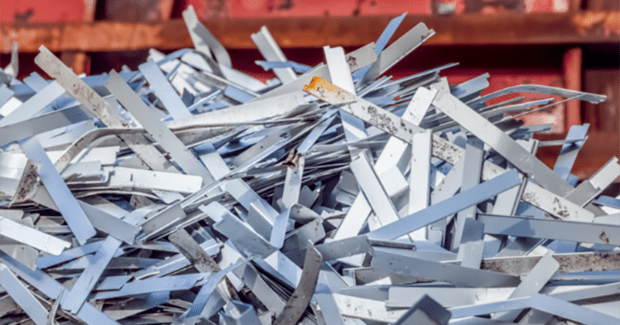Sheariously Awesome Ironworker Automation
Automating the shear section of an ironworker with a simple stop and some software is a relatively easy way to reduce cycle times on both shearing and setup and improve part accuracy, eliminate rework, and improve material yield.
Posted: December 28, 2016
Steel, aluminum, copper and other types of sheet metal are used in an array of metalworking applications, including tube and pipe, aerospace, automotive, building construction, general fabrication and a surplus of other industries across the globe. The shear section of an ironworker is ideal for cutting through these various types of sheet metal. In fact, there are many different ways to shear sheet metal and more with an ironworker: in addition to a notching station and a punch press, a good ironworker will have options that include an angle shear, flat shear and round bar shear, among others. When shopping for an ironworker, it’s important to ensure that (1) you are investing in a good clean, burr-free shear and (2) you are able to cut accurate part lengths on the shear. Accuracy is vital to the profitability of the entire manufacturing operation.
ACCURACY ABOVE ALL
Shearing accuracy is wildly important due to high raw material costs. Nothing drains profits from a shop more than sending wasted materials out the door. Huge piles of scrap sheet metal waste are a signal of serious manufacturing problems that are happening on the shop floor due to operator errors or machining problems. Measuring difficulties are the likely culprit: using a tape measure or a manual stop is slow and often times inaccurate. Finding skilled operators who can adeptly measure and mark parts on the fly is no easy feat. Even using manual stop blocks/gauges can pose problems because manual blocks are frequently bumped during the shearing process, which can result in fractional errors. If the shear operator is cutting thousands of parts a day, that fractional error can compound and lead to huge inaccuracies.
Another area that can cost a metal shearing operation a great deal of money is operator/labor time. A significant amount of time is required to set and reset manual stops. Sometimes a setup can take anywhere from 30 seconds to one minute prior to shearing. Multiply that single setup time by hundreds of setups each day and it reveals how a busy shear operation can still lose hours of time. But that’s not all, because the area where the most overall time is lost time occurs whenever parts are cut inaccurately and the operator has to fix his error. Rework is nothing less than spending money on an unnecessary added process.
THE DANGERS OF REWORK
Rework is dangerous because it not only costs a lot in hourly wages, it can cost even more in wages if non-conforming parts are being corrected after hours (think time and a half salary). Rework slows down the entire production process, which in turn slows down the flow of all other processes down the line. But even more dangerous than rework is overlooking a defective part that needed to be reworked and finding out that a customer received it. This can be incredibly damaging to a company’s reputation – a risk that emphasizes why cutting sheet metal parts quickly and accurately the first time around is absolutely vital.
ADD-ON AUTOMATION AND THE IRONWORKER
Automating the shear section of an ironworker with a simple stop is a relatively easy way to combat these sheet metal processing issues and save a tremendous amount of money. Add-on automation dramatically cuts down time on both shearing and setup. This reduces operator labor/fatigue as well as hours, which in turn reduces and even eliminates the need to rework parts, thereby shrinking scrap waste and more. Having flexible and customizable ironworker automation is an even bigger plus. A wide range of products are now available to attach to the shear section of an ironworker, whether it’s a brand new model or a 15-year-old, barely recognizable version of its old self.
For example, a basic stop called a SawGear® easily attaches to an ironworker shear as one of the simplest, most cost effective solutions for increased speed and dead on accuracy. The SawGear is a highly portable automated saw fence that removes the need to set and adjust manual fences for length positioning and complex miter/angle cutting. The operator simply types in the part length that is required to cut and then presses start. If the operation requires heavy materials to be pushed through the shear, then the TigerTurbo high speed automated feeder can push and position material up to 350 lb without rollers or up to 840 lb with roller tables at up to 180 fpm with its steel reinforced belt. For even heavier materials, the HeavyDuty 2 high speed automated feeder can push and position loads up to 2,100 lb at ± .008 in (.2 mm) accuracy, for perfectly cut parts every time.
OPTIMIZATION SOFTWARE MAXIMIZES MATERIAL YIELD
Another great way to save money on raw materials is by nesting parts: instead of shearing the longest parts first, then shearing the shortest parts, then tossing the leftover scrap in the garbage, use software that shows how to nest the parts to maximize material yield with the least amount of scrap waste at the end. For example, Dynamic Optimization™ software is easy to use nesting software for shearing applications that is a great way to get the most out of raw materials. This software will nest the parts, cut around defects in material, and provide accurately sheared lengths, all while maximizing material yield. It also allows use of all of the remnant parts (the large “skeleton” pieces of sheet metal that remain after parts have been cut from the sheet) that have been left over in the shop for months. By incorporating these remnants into the cut list, Dynamic Optimization software allows the shop to use their “worst first” material configurations when shearing.
TigerStop LLC, 12909 NE 95th Street, Vancouver, WA 98682-2426, 360-254-0661, www.tigerstop.com.





